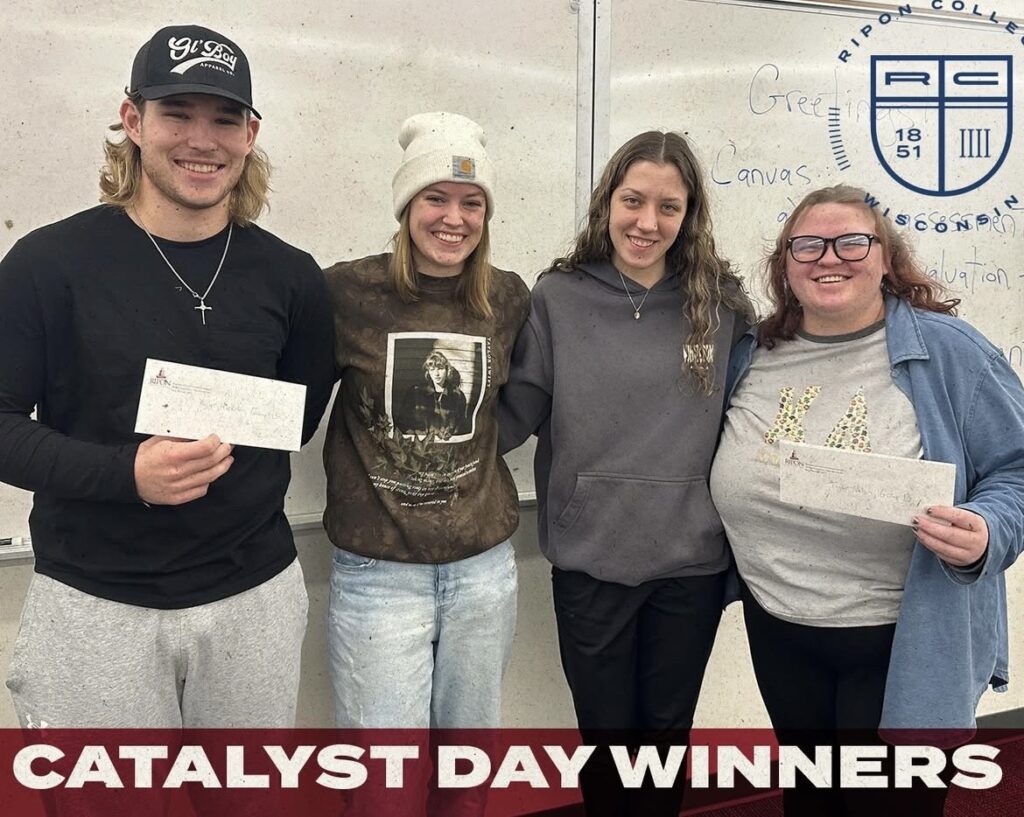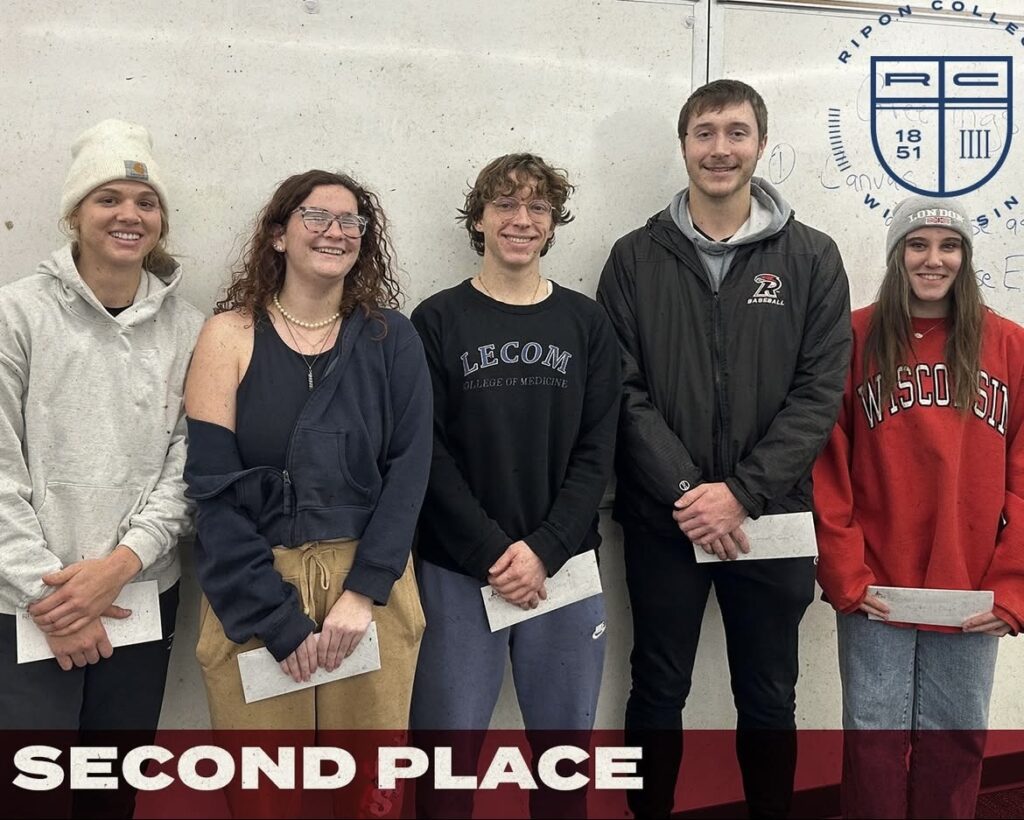By Miki Canak in College Days, Feature Story on January 12, 2025
First and Second-Place Group Share Advice for Future Presenters
Catalyst Day is an event held every semester designed to exhibit Ripon College’s Catalyst curriculum and celebrate the achievements of junior-level collaborative capstone-completing students.
Listeners have the opportunity to watch several of these presentations on Catalyst Day when teams of students share their problem-solving projects aimed at tackling issues in the real world.
At the beginning of each Catalyst 300 course, students are placed into groups and then choose from a variety of challenges to research, write, and present about. Fall 2024 challenges and topic names included: Energy Crisis, Voting Matters, “The Four Elements”, Social Media, and Public Health and Minorities.
Students may also create their own “wild card” option for which they choose a topic they are passionate about on their own, given they receive approval from faculty members.
The winners of the Catalyst Day oral presentation awards were announced last Friday afternoon and were later posted on Ripon College’s Instagram page.

Group 13 poses after their win: from left, Kyler Hickman, Sydney Swanson, Natalie Weidner, and Taylor Nelson. Photo Courtesy of Ripon College.
The first-place winning team was Group 13, with Sydney Swanson, Natalie Weidner, Kyler Hickman, and Taylor Nelson. They presented “Preventing Hell on Earth: How Livestock Grazing Can Save Sequoia National Forest from Complete Destruction” at 10:00 AM in Great Hall.
Their project covered livestock grazing as a wildfire prevention strategy in Sequoia National Forest, and they explained how targeted grazing can reduce dry fuels and create fire breaks. It aimed to protect ecosystems and nearby communities from wildfire spread by integrating natural grazing habits into wildfire control.
Natalie Weidner, a junior majoring in biology with a minor in chemistry, is looking to pursue a career in medicine.
“I was involved with some of our stakeholders and writing the speech that we gave on Catalyst Day. Some of my group members were more involved in writing the paper, but we worked together on the research that brought it all together,” she said.
A stakeholder is a phrase used for their interviewees.
Their solution involved collaboration with state and local governments, farmers, and ranchers, and was estimated to cost less than 1% of California’s $3 billion annual firefighting budget.
“Preventing wildfires would eventually lower yearly expenses as a whole, saving money for the state. Farmers and ranchers would be compensated by us or our program, and we would cover the yearly property tax for their cattle-holding facilities,” Weidner said.
Kyler Hickman, a junior majoring in finance and minoring in coaching, handled budgeting calculations related to costs for livestock fencing and overall fire prevention strategies.
“We had a rocky start and did not come across our final idea until halfway through the semester. Michael Frederick, a firefighter for the Tracy Fire Department in California, mentioned larger mountains that have livestock on them. He said that they fight fewer fires around those areas, so we began researching this idea,” Hickman said.
“Our first two ideas were not implementable. We found from one of our stakeholders that one of our ideas was not going to work because of legal changes in California. Our second idea was so expensive that we did not think it was the best solution that we could come up with,” Weidner said.
Weidner said that their group had a memorable breakthrough the night before Catalyst Day when we were running through their speech fully for the first time. They realized that they were going to hit the time necessary to pass the course, that they sounded very cohesive, and that they felt that the project had finally come together.
“We were not planning on winning, nor did we think we even had a chance. When I spoke with our final stakeholder, Dr. Chris Underwood, he asked me if we had legitimate funding for this project because he thought it was so implementable that he wanted to work with us to make it happen,” Weidner said.
“We knew the information very well, but we were a little nervous to get up there and recite it in front of a big group of people. We had to figure out the taxes, fencing, zones, as well as the number of cattle, and the timelines that we would have to use. Along with that, we realized partway through that we would need permits because it was federal land, so we had to go into detail on how we would receive those permits,” she said.
Group 13 earned accolades from a judge, who considered their presentation one of the best in Catalyst Day history.
“At first, we were only trying to pass the presentation for our course, and then it turned into something that we were passionate about. We wanted to win,” Hickman said.
Hickman and Weidner noted that the experience improved their public speaking skills and advised future presenters to embrace their ideas fully.
“Students presenting in the future should trust themselves. You will spend so much time learning this information, and you will understand it way better than you think you do. If you can get up there and sound confident you will present it so much better. I had an amazing group, and it made it so much easier to get through the competition. But, communication was necessary. Make sure you are pulling your weight and trusting yourself with the information you are presenting. Look into every necessary detail to make sure yourself feel comfortable, and you will do great,” Weidner said.

Group 9 poses after winning second place: from left, Natalie Rauwolf, Katy Peterson, Sean Rath, Caleb Mammoser and Mary Elliott. Photo Courtesy of Ripon College.
Group 9, with Katy Peterson, Sean Rath, Natalie Rauwolf, Caleb Mammoser and Mary Elliott, won second place and presented “Rooted in Agroforestry: Enhancing Soil Health through Sustainable Practices in Wisconsin and Iowa” at 2:00 PM in Great Hall.
They addressed the significant and escalating problems of soil erosion and nutrient depletion in the Corn Belt, particularly in Wisconsin and Iowa. These issues are intensified by modern farming practices which include intensive tillage, the lack of cover crops, the use of monocultures, excessive water use, and overreliance on chemicals.
Natalie Rauwolf is a junior majoring in Sports Management and minoring in Strength and Conditioning and Coaching.
“We chose to focus on this topic because we wanted to emphasize sustainability and environmental preservation, especially given the added challenges posed by climate change, which is increasingly impacting both the environment and farmers,” she said.
Their solution focused on promoting agroforestry as a sustainable farming practice to address soil erosion and nutrient depletion in Wisconsin and Iowa.
“What stood out to the judges was the holistic nature of our solution. We did not just focus on soil health; we considered how agroforestry could simultaneously address environmental, economic, and social challenges. The focus on actionable steps, and practical implementation for local farmers, along with educating farmers about our agroforestry brochure that we created and handed out to the judges during our presentation,” Rauwolf said.
By integrating trees, shrubs, and other perennial plants into traditional crop systems, they aimed to improve soil health, enhance biodiversity, and reduce water runoff. They also emphasized educating farmers on the long-term economic and environmental benefits of these practices, including improved yields, carbon sequestration, and enhanced resilience to extreme weather.
“My role was to step up as a leader, even though it was not something I initially thought I’d want to do. On the basketball court, I strived to be a leader, but when it came to our group, I wasn’t sure if I could or even wanted to take on that responsibility. However, I found myself having to step up and play the ‘bad guy’ at times—making sure everyone stayed on track and did their part. It wasn’t always easy, but I learned that leadership is about more than just guiding people; it’s about holding the team accountable and keeping things moving forward, even when it feels uncomfortable. This experience helped me realize that leadership isn’t just about taking charge, but about pushing the whole team toward success, even when it means stepping into tough roles,” Rauwolf said.
Sean Rath, a junior majoring in biomedical science and integrated computer science-physics, said, “We just addressed any issues that we ran into with our group, and then quickly resolved them together.”
Rath said that they were not focused on coming in first or second place, but that it was most important to them to showcase the quality of their presentation.
“Making sure everyone was calm and confident was important to me. We were sitting in the back of Great Hall as we were scheduled as one of the final presenters, and I felt a sense of nervousness that I knew we could overcome,” he said.
Rath advises future Catalyst Day presenters to make sure that all the contributions toward their project are of the highest possible quality.
“Make sure to be either on time or ahead of schedule, if possible. Do a lot of research, and then you can go back and change your plan if needed,” Rath said.
The key to their success was addressing issues during practices and maintaining confidence. The judges praised their economic section and brochures.
Caleb Mammoser is a junior majoring in Business Management and minoring in Economics.
“My role within the group was looking into the existing solutions and finding their deficits that our solution could help fix,” he said.
Mammoser said that the most challenging part of creating the presentation was figuring out how to allocate different presentation topics amongst their group members, which they overcame after practicing multiple times.
“We did not get any questions or feedback that we were unprepared for or could not answer. This competition me more confident in my public speaking skills,” Mammoser said.
Despite facing challenges and disagreements, the team effectively managed their workload and stakeholder communication. They emphasized quality over competition, which contributed to their strong presentation and eventual second-place win.
“My advice to other students preparing for similar competitions would be to believe in yourself, even through the doubts and struggles. I wasn’t always confident, especially when it comes to public speaking. Despite playing basketball in front of huge crowds, speaking in front of judges and a large crowd was a whole different challenge for me. I had a lot of fears and doubts leading up to Catalyst Day. But, I learned that growth happens when you push through those discomforts and put trust in God that He will give me the strength to get through all the trials and tribulations that I will face. Continue to put your faith over your fear,” Rauwolf said.
Students are encouraged to attend Catalyst Day presentations to learn more about how their classmates present current events, problem-solve, and practice communication skills.
The Catalyst curriculum is an integral aspect of Ripon College that continues to shape new ideas and perspectives among presentation listeners and speakers.


